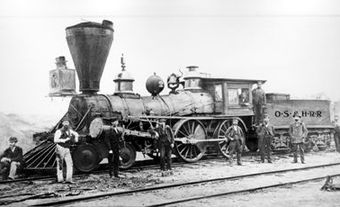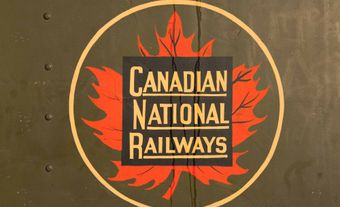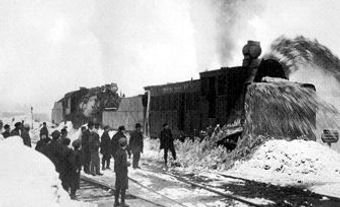Ewing Hunter Harrison III, president and CEO of Canadian National Railway Company 2003–09, CEO of Canadian Pacific Railway Limited 2012–17 (born 7 November 1944 in Memphis, Tennessee; died 16 December 2017 in Wellington, Florida). Best known as the leading proponent of Precision Scheduled Railroading, Hunter Harrison ran four publicly traded, Class 1 railroads during his more than half century in the industry. His leadership of Canada’s two largest railway companies greatly improved the efficiency and profitability of both businesses.
Click here for definitions of key terms used in this article.

Hunter Harrison at his Florida home on the day in January 2017 that he signed the papers to resign as CEO of Canadian Pacific Railway.
Early Life and Education
Known by his middle name, Hunter, Harrison was the first child of Dorothy Harrison and Ewing Hunter Harrison Jr., a Memphis police officer. He was an only child for six years until his sister Mary arrived, followed by sisters Sydney, Diane and Helen. In 1962, Harrison graduated from Kingsbury High School. He married Jeannie Day of Memphis in 1963. They divorced in 1969 and remarried in 1970.
Early Career
Hunter Harrison’s first rail job was working as a carman-oiler in a Memphis railyard, starting in December 1963. This involved pouring oil that lubricated axle bearings on boxcars at the St. Louis–San Francisco Railway Co., later bought by Burlington Northern (now BNSF Railway). With only a high school diploma, Harrison worked his way up in the company. He had an uncanny ability to move thousands of boxcars more efficiently than others. (Harrison likened railroad logistics to high-speed checkers.) Management noticed and consistently promoted him. Over the course of his career, he would move cities some 20 times.
Career at Illinois Central
In the late 1980s, Hunter Harrison’s career stalled at Burlington Northern. In 1989, Illinois Central (IC) Railroad Company in Chicago hired him as vice president and chief transportation officer. The company had been purchased by an investment group that sought to turn the struggling business around.
Harrison was tasked with making the railroad more efficient by lowering the operating ratio (expenses divided by revenue). He went on to achieve record results through his philosophy of Precision Scheduled Railroading. This approach measured every aspect of performance, from the time required for boxcar inspections to the cost of assets such as track and locomotives. For decades prior, freight railroads did not run on set schedules and lost money. Harrison changed that, improving speed, reliability and pricing. In February 1993, Harrison became CEO of Illinois Central. He went on to make it the most efficient major (Class 1) railroad in the United States and Canada.
Did you know? Illinois Central was one of the original “land grant” railroads in the United States. A federal government land grant of some 3 million acres helped establish IC in 1851. It subsequently became the essential rail line down the Mississippi River from Chicago to New Orleans. In its earliest days, Abraham Lincoln (the US president during the country’s civil war) was a lawyer for the railroad.
Career at CN
In 1998, Illinois Central was purchased by Canadian National Railway Company (CN). This was CN’s means of creating a railroad that would capitalize on the new North America Free Trade Agreement (NAFTA). Hunter Harrison was initially resistant to joining CN, but ultimately signed on as chief operating officer. He held this position from March 1998 to December 2002. When CN CEO Paul Tellier left the company to run Bombardier, Harrison became CEO in January 2003. Under his leadership, CN became the most efficient Class 1 railroad in North America. Harrison, who was also resistant to learning French even though he ran a Quebec-based company, famously opened a meeting with the greeting, “Bonjour y’all.”
Harrison retired from CN at the end of 2009 at the age of 65, dejected that the company said it didn’t need him anymore. But he would make a dramatic, headline-grabbing comeback in 2012. Harrison joined forces with a well-known activist investor from the United States, William Ackman of Pershing Square Capital Management (Pershing). Pershing had become the largest shareholder in Canadian Pacific Railway Limited (CP). CP had vastly underperformed its peers and Pershing was determined to force a turnaround. As the centrepiece of its strategy, Pershing demanded CP replace its CEO with Hunter Harrison. CP’s resistance resulted in a bitter, public proxy contest between the American investor and the iconic Canadian company. In a shareholder vote at CP’s annual general meeting in May 2012, Pershing prevailed. Harrison was appointed CEO the following month.
Career at CP and CSX
Although many considered his measures harsh, Hunter Harrison also had many supporters. He rapidly changed the fortunes of CP. By the time he departed in January 2017, CP’s efficiency was on par with CN’s. At 72 years of age and after engineering three turnarounds, Harrison would not stop working despite a serious decline in his health. Once again, he joined with an American activist investor, Mantle Ridge LP run by Paul Hilal, formerly of Pershing. Harrison and Hilal targeted a large, underperforming American railroad, CSX Corporation. Canadian Pacific had unsuccessfully tried to merge with CSX during Harrison’s tenure at CP. On 6 March 2017, Harrison became CEO of CSX, which he ran until his death in December of that year.
Legacy
Over the course of Hunter Harrison’s four turnarounds, shareholders benefited by approximately US$50 billion. Since his death, in addition to CN, CP and CSX, all but one of the other four Class 1 railroads in North America have adopted his philosophy of Precision Scheduled Railroading or some form of it.

Hunter Harrison in his office at CSX Corp. in Jacksonville, Florida, in July 2017, six months before he died.

 Share on Facebook
Share on Facebook Share on X
Share on X Share by Email
Share by Email Share on Google Classroom
Share on Google Classroom





